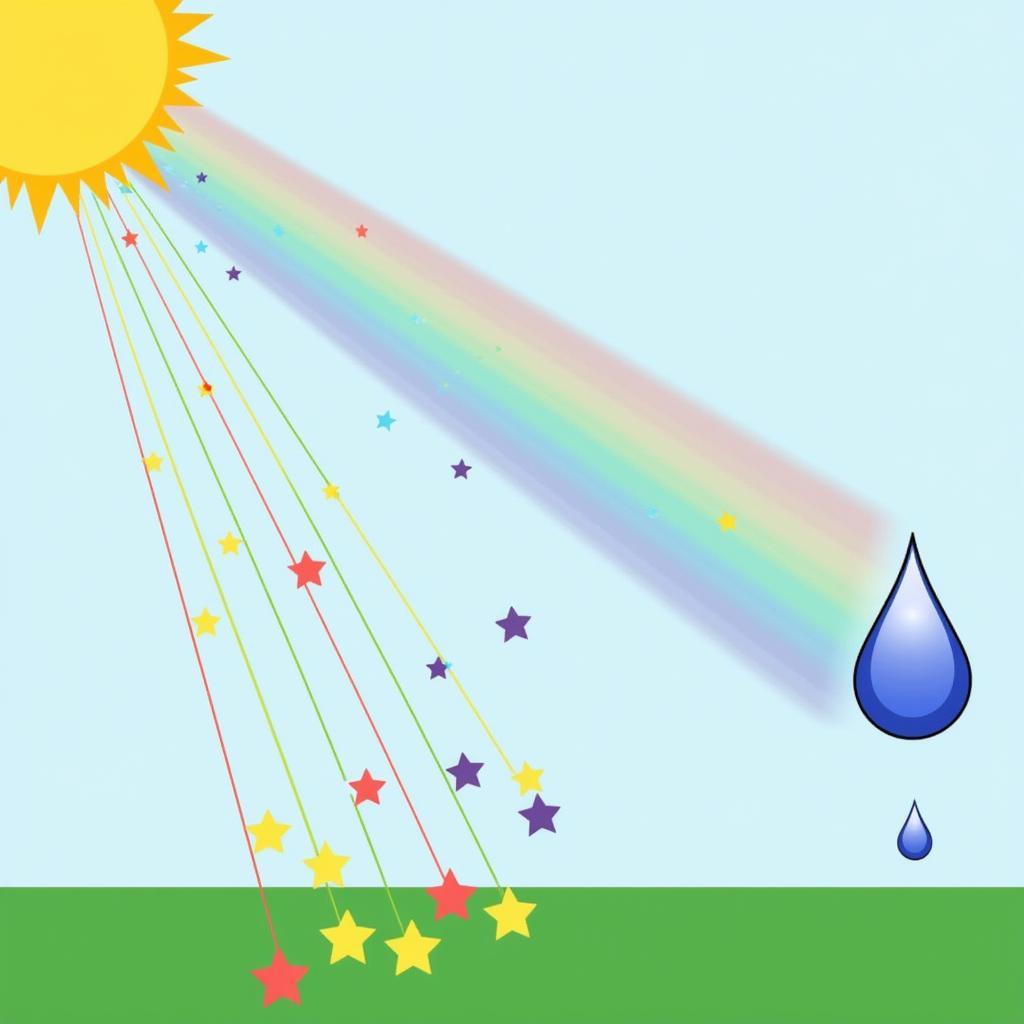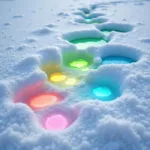“De Qué Color Es Un Arcoiris?” you might ask. It’s a simple question that unlocks a world of wonder about the colorful arc we see in the sky. While we often say the rainbow has seven colors, the reality is a bit more nuanced. A rainbow is actually a continuous spectrum of colors, blending seamlessly from one hue to the next.
Unpacking the Science Behind the Spectrum: How Rainbows Form
To truly appreciate the answer to “de qué color es un arcoiris,” we need to understand how this meteorological masterpiece is created. Sunlight, appearing white to our eyes, is actually comprised of a spectrum of colors. When sunlight passes through water droplets in the air, something magical happens:
- Refraction: Light bends as it enters and exits the water droplet, like a car changing direction as it moves from pavement to grass.
- Dispersion: The different colors of light bend at slightly different angles. This separates the white light into its individual colors, much like a prism.
- Reflection: The light bounces off the back of the water droplet.
- Second Refraction: As the light exits the droplet, it refracts once more, further separating the colors.
This process creates the arc of colors we call a rainbow.
 Rainbow Formation
Rainbow Formation
The Seven Colors We Perceive: ROYGBIV
While a rainbow contains a vast spectrum of colors, we often simplify it into seven distinct hues:
- Red
- Orange
- Yellow
- Green
- Blue
- Indigo
- Violet
This arrangement, easily remembered by the acronym ROYGBIV, represents the visible light spectrum from longest to shortest wavelength.
 Visible Light Spectrum in a Rainbow
Visible Light Spectrum in a Rainbow
However, it’s crucial to remember that these seven colors are simply convenient categories. In reality, countless subtle shades exist between each, blending seamlessly together.
Beyond the Visible: Colors We Can’t See in a Rainbow
Did you know that a rainbow actually contains more colors than our eyes can perceive? Beyond the red end of the visible spectrum lies infrared light, and beyond violet lies ultraviolet light. These are just as much a part of the rainbow as the colors we can see, but our eyes are not equipped to detect them.
The Magic of Perception: Why We See Rainbows Differently
You might be surprised to learn that no two people see the exact same rainbow. This is because:
- Angle of Observation: A rainbow’s appearance is dependent on the angle of the sun and the observer’s position.
- Size of Water Droplets: The size of the water droplets creating the rainbow affects the intensity and width of the color bands.
- Individual Perception: Our eyes and brains interpret color slightly differently, meaning what one person sees as a vibrant red might appear slightly different to someone else.
Capturing the Rainbow: Photography Tips
how to say colorful in spanish
Photographing a rainbow can be tricky, but with the right technique, you can capture its fleeting beauty. Here are a few tips:
- Look for Rainbows After a Rain Shower: Rainbows are most commonly seen when the sun breaks through the clouds after rain.
- Use a Polarizing Filter: A polarizing filter can help to reduce glare and enhance the colors of the rainbow.
- Choose a Wide-Angle Lens: A wide-angle lens will allow you to capture the full arc of the rainbow.
- Experiment with Different Compositions: Try including elements of the surrounding landscape in your composition to add interest and context.
Beyond the Sky: Rainbows in Our Everyday Lives
While we typically associate rainbows with the sky, we encounter the same principles of light and color in various aspects of our lives:
- Soap Bubbles: The iridescent, swirling colors on a soap bubble are created by the interference of light waves reflecting off the thin soap film.
- CDs and DVDs: The grooves on a CD or DVD act like a diffraction grating, separating white light into its component colors.
- Diamonds: The facets of a cut diamond refract and disperse light, creating the stone’s signature sparkle.
“De qué color es un arcoiris” is a question with a multifaceted answer. A rainbow is a breathtaking example of nature’s artistry, reminding us that beauty can be found in the most unexpected places – even in the refraction and reflection of light through water droplets. The next time you see a rainbow, take a moment to appreciate the science and wonder behind this colorful spectacle.
Frequently Asked Questions about Rainbows
1. Can you see a rainbow at night?
While rare, it is possible to see a “moonbow” at night. Moonbows are created when moonlight, rather than sunlight, is refracted and reflected through water droplets.
2. Do rainbows really have an end?
Although depicted in art and literature as having an end point where a pot of gold might lie, rainbows are actually circular. We typically only see an arc because the horizon cuts off the bottom portion of the circle.
3. Can you create a rainbow?
Yes! You can easily create a rainbow on a sunny day using a garden hose or a spray bottle. Simply stand with your back to the sun and mist water into the air.
4. Why are rainbows curved?
The curved shape of a rainbow is due to the way that light is refracted and reflected through water droplets. The arc of the rainbow is always centered on the antisolar point, which is the point directly opposite the sun in the sky.
5. What is a double rainbow?
A double rainbow occurs when light is reflected twice inside a water droplet. The second rainbow appears fainter and with its colors reversed.
Need help with color selection or creating a vibrant space?
Contact Color Box Hà Nội today!
Phone: 0373298888
Email: [email protected]
Address: 86 Cầu Giấy, Hà Nội
We’re here to help you bring your vision to life!

